#consolidated edison
Text

Foam, East River, NYC, 2024
GIF: Bruce Morrow
#bruce morrow#brucemorrow#bruce-morrow#digital art#the moment that#my art#myart#animated gif#animated gifs#nft digital art#sludge#east river#foam#nyc#gifs on tumblr#my gif#looping gif#my gifs#gifs#con Ed#consolidated Edison
12 notes
·
View notes
Text







#peekskill#caveat emptor#grifters#green grifters#buyer beware#don’t fall for it#Cleanchoice Energy#Con Edison#ConEd#Consolidated Edison#peekskill ny#peekskill new york#peekskill n.y.#city of peekskill#hudson valley#hudson valley ny#city of peekskill new york#westchester#hudsonvalley#westchester county#peekskillny#hudson valley new york#cityofpeekskill#city of peekskill ny#power to choose
0 notes
Text
Cosplay the Classics: Nazimova in Salomé (1922)—Part 2

My cosplay of Nazimova as Salomé
As the studio system emerged in the American film industry at the start of the 1920s, many of the biggest stars in Hollywood chose independence. Alla Nazimova, an import from the stage, was one of them. In 1922, she made a series of professional and creative decisions that would completely change the trajectory of her career.
In part one of CtC: Nazimova in Salomé, I described how Nazimova’s independent productions were shaped in response to trends and ideas surrounding young/independent womanhood in America after World War I and the influenza pandemic. Here in part two, I’ll fit these productions, A Doll’s House and Salomé, into the broader context of the big-money business of film becoming legitimate in America.
While the full essay and photo set are available below the jump, you may find it easier to read (formatting-wise) on the wordpress site. Either way, I hope you enjoy the read! Oh and Happy Bi Visibility Day to all those who celebrate!
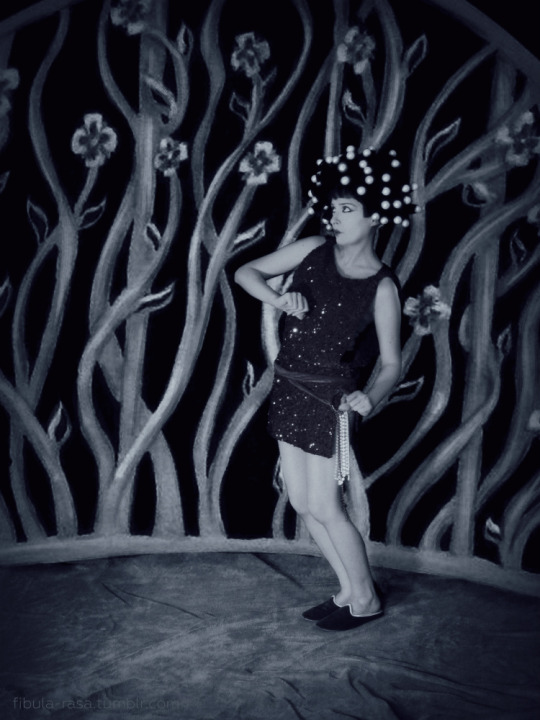
My cosplay of Nazimova as Salomé
Artists United? Allied Artists and the Release of Salomé
When Nazimova made her screen debut in War Brides (1916), the American film industry was undergoing a series of formative changes. Southern California became the center of professional filmmaking in the US—fleeing New Jersey (where War Brides was filmed) largely because of Thomas Edison’s attempts to monopolize the business. Preferences of audiences and exhibitors shifted away from one and two-reel films and towards feature-length films. The Star System emerged in full force. Nazimova soon relocated to Hollywood, signed a contract with Metro, and reaped the benefits of this boom period for American film artists.
The focus on feature-film production and the marketing of films based on the reputations of specific filmmakers or stars required a greater initial outlay of resources—time, money, and labor. But, it also paid dividends—the industry quickly grew into a big-money business. The underlying implication of that is that a larger share of the profits were shifted from the people doing the creating (artists and technicians) and towards other figures (capitalists). In practice, this also meant film companies would become eligible for listing on the stock exchange and could secure funding from banks and financial institutions, both of which were rare or impossible before the mid-1920s. The major players on the business end of production, distribution, and exhibition, therefore, wanted to consolidate their power and reduce the power and influence of the filmmakers.
To illustrate how momentous this handful of years was in the history of the US film industry, allow me to highlight a few key events. Will Hayes’ office was set up in 1922 to make official Hollywood’s commitment to self-censorship. Eastman Kodak introduced 16 mm film in 1923, a move which, while making filmmaking more accessible and affordable, also widened and formalized the division between the professional industry and amateur filmmaking. Dudley Murphy’s “visual symphony” Danse Macabre[1] was released in 1922—considered America’s first avant-garde film. Nazimova’s Salomé was considered America’s first art film from its initial release in 1923. That these labels were deemed relevant in this period illustrates the line being drawn between those films and film as a conventional, commercial product. The concept of art cinemas in the US was first proposed in 1922 spurring on the Little Cinema movement later in the decade.

from Danse Macabre

from Salomé
As any industry matures, both the roles within it and its output become more starkly delineated. That is to say that, as the US industry began differentiating between art/avant-garde/experimental film and commercial film, the jobs within professional filmmaking also became more firmly defined. Filmmaking has always been a collaborative art, but in the period prior to the 1920s, it was common for people in film to do a little of everything. As a result, what sparse credits made it onto the final film didn’t necessarily reflect all of the work that was done. To illustrate this using Nazimova,[2] at Metro, she had her own production unit under the Metro umbrella. While her films were “Nazimova Productions,” she didn’t have full creative control of her films. However, Nazimova did choose her own projects, develop said projects, and contribute to their writing, directing, and editing. When those films were released, aside from the “Nazimova Productions” banner, her only credit would usually be for her acting. Despite that impressive level of creative power, the studio still had the ultimate say on whether a film got made, and how it would be released. As studios grew and tightened control of their productions, this looser filmmaking style became much less common.
The structure of the industry at this time was roughly tripartite—production, distribution, and exhibition. Generally speaking, the way studio-made films traveled from studio to theatre—before full vertical integration—was that the production company would make available a slate of films of different scales. (Bigger productions with bigger names attached would have a special designation and come with higher rental fees.) Famous Players-Lasky was the biggest production house at the time, though other studios, like Metro, were quickly catching up. Distribution companies would then place this slate of films on regional exchanges, centered in the biggest cities in a given region. Exhibitors (this could be owners of chains like Loew’s in the Midwest and Northeast, the Saengers around the gulf coast, or individual theatre owners) could then rent films through their local exchanges. (This was an ever-shifting industry, so this process was not true for every single film. This is only meant as a quick overview of the system.) As the 1920s wore on, exhibitors began entering the production arena and producers further merged with distribution companies and exhibition chains. Merger-mania was the rule of the day.

My cosplay of Nazimova as Salomé
As merger upon merger took place and a handful of businessmen tried to monopolize the industry, American filmmakers responded by championing the artistic legitimacy of filmmaking in the US. Leading this charge were the very filmmakers on whose backs the big business of film had been built. As noted in Tino T. Balio’s expansive history of United Artists, The Company Built by the Stars:
…Richard A. Rowland, president of Metro Pictures, proclaimed that ‘motion pictures must cease to be a game and become a business.’ What he wanted was to supplant the star system, which forced companies to compete for big names and pay out-of-this-world salaries for their services. Metro, he said, would thenceforth decline from ‘competitive bidding for billion-dollar stars’ and devote its energies to making big pictures based on ‘play value and excellence of production.’”
It’s notable for us that these ideas were espoused by Rowland, head of the studio where Nazimova was currently one of those “billion-dollar stars.” (“Billion-dollar” is obviously a massive overstatement.) It was a precarious time for any filmmaker who cared about the quality and artistry of their work. It was this environment that birthed United Artists, a new production company built around the prestige and reputation of its filmmakers, Douglas Fairbanks, Mary Pickford, Charlie Chaplin, and D.W. Griffith. As the statement announcing the formation of UA detailed:
“We also think that this step is positively and absolutely necessary to protect the great motion picture public from threatening combinations and trusts that would force upon them mediocre productions and machine-made entertainment.”
It’s an accurate assessment of industry trends at the time. If the desired product is a high-quality feature-length film, production is necessarily more expensive. As the UA statement intimates, monopolizing the entire industry and sacrificing quality for quantity to fill the exchanges and theatrical bills was the studio heads’ solution to rising costs. Not a great signal for filmmaking as art in America.

My cosplay of Nazimova as Salomé
So, Nazimova was in good company when she chose to go independent, believing in film as art and that American moviegoers deserved better than derivative, studio-conceived films. Some of the other artists who went independent included George Fitzmaurice (one of the most revered directors of the silent era, though most of his films are now sadly lost), Charles Ray, Max Linder, Norma Talmadge (in alliance with Sam Goldwyn), and Ferdinand Pinney Earle (whose massive mostly-lost artistic experiment Omar Khayyam, I profiled in LBnF). If these filmmakers shared the motivation of UA to create higher-calibre productions, where would the money come from? For Nazimova, the answer was her own bank account.
In 1922, Nazimova’s final film for Metro, Camille (1921), was still circulating widely due to the rising popularity of her co-star, Rudolph Valentino, after the release of Four Horsemen of the Apocalypse (1921) and The Sheik (1921). While Nazimova had the funds to complete A Doll’s House and Salomé, there was no sure bet for the films’ releases. Nazimova’s initial concept for her independent productions was the “repertoire” film. This scheme would have seen A Doll’s House released as a shorter film with Salomé as a feature and the two could be rented as a package by exhibitors. It was a creative response to growing tensions between producers and exhibitors over a practice called block booking. Block booking was a strategy studios employed to leverage the Star System to its fullest. They would take the most in-demand films associated with the biggest drawing stars and only make them available in a package deal with productions that were perceived as less marketable. Nazimova was aware that her films at Metro had been rented this way (as the special feature). It’s not completely clear from my research if the decision to release Salomé and A Doll’s House as two features was creative, practical, or a combination of the two. The “repertoire” concept may not have gone according to plan, but it was an early indication that Nazimova was well-informed of the nuances of distribution and exhibition.
Nazimova’s need for proper distribution was met by United Artists’ distribution subsidiary, Allied Artists. United Artists’ first few years were a struggle. Fairbanks, Pickford, and Griffith[3] needed significant time and money to finish the high-quality productions that they promised and Allied was their solution. This distribution arm would release the work of other independent talent using the same exchanges as UA, but under a different banner. Though Allied used UA’s exchanges for distribution, the subsidiary had its own staff. Allied having different branding would also protect the prestige of the UA name. (An unkind, but not entirely inaccurate summary: the money your work brings in is good enough for us, but your work is not.) Allied would have a full release slate to generate the revenue that UA needed to remain in operation.
Nazimova was one of the filmmakers who signed a distribution deal with Allied and had reason to regret it—though she and Charles Bryant didn’t openly rag on UA/Allied.[4] Notably, Mack Sennett had arranged the release of Suzanna (1923) through Allied and was vocal about the company bungling its release. Differences over distribution and exhibition would also lead to Griffith’s exit from the company and a major rift between Chaplin and Pickford-Fairbanks. After 1923, Allied reduced its operation, at least in part because of the bad reputation they were garnering with other filmmakers. Despite numerous independents losing money on productions released through Allied, by 1923, Allied had netted UA 51 million dollars in revenue!
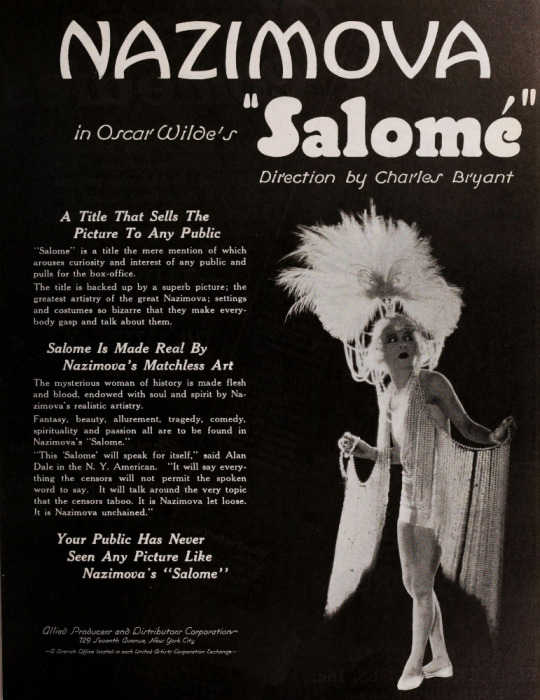
Trade ad for Salomé from Motion Picture News, 10 March 1923
The questionable deals that these independent filmmakers received with Allied are often mentioned in discourse about the period, but very, very rarely does anyone offer details of what Allied’s inadequate distribution looked like. Using the information available to me via Lantern, I collected and analyzed data regarding the release and exhibition of Nazimova’s final two Metro films and both of her Allied films.[5] Looking at the trade publications Exhibitor’s Trade Review, Moving Picture World, Motion Picture News, and Exhibitors Herald, I categorized every item I found about the release or exhibition of Billions (1920),[6] Camille, A Doll’s House, and Salomé. The “release” items are primarily advertisements, reviews, and news items about release dates or pre-release screenings. The number of these items for all four films were comparable.
The items in the “exhibition” category, however, reveal a marked difference between the Metro and Allied releases. This category includes items like first-run theatre listings, exhibitor feedback, and advertising advice for theatre owners. Only counting exhibition items from the first two years (24 months) from the initial release of each film, Billions and Camille had twice as many items as A Doll’s House and Salomé!

While this isn’t necessarily hard data on how many theatres ran each film, it is a rough indicator of how well the films circulated. This data suggests that neither A Doll’s House or Salomé had distribution comparable to the Metro films. In order to compensate for the Rudy factor—Valentino’s major rise to stardom in 1921—which could have affected Camille’s numbers in a big way, I included Billions as well. Billions was sold as a special (a bigger production with premium rental fees) on Nazimova’s name alone. It was not especially well received. Exhibitors/theatre owners had mixed feelings on the film because Nazimova’s previous film, Madame Peacock (1920), had underperformed. Many exhibitors viewed Billions as an improvement, though it still did not meet their perception of Nazimova’s standard of quality. Despite that, Billions had 76 exhibition-related items across its first 24 months of availability to Camille’s 80.
To get a little deeper into this data, I wanted to see how the feedback from exhibitors and theatre owners compared. I broke down the exhibitor feedback for each film as positive, middling, or negative based on how the exhibitors assessed audience response and/or box office receipts. (I discounted feedback that only reflected theatre owners’ own personal assessment of the films without mention of their patrons or receipts.) Positive feedback could be good reception and/or good receipts, middling suggests only average business and no noteworthy reception, and negative indicates poor response and/or poor ticket sales. Since there are so many more items about Camille and Billions than A Doll’s House and Salomé, I compared ratios as an indicator of exhibitor satisfaction. The results were truly surprising.




Theatre owners who rented Salomé may have been in significantly smaller numbers than those who ran Camille, but their satisfaction with ticket sales and audience feedback was roughly equivalent. (Though slightly more positive for Salomé!) The numbers for Billions line up with the qualitative assessment I summarized above, displaying a roughly equal 3-way split. A Doll’s House was the most divisive with the highest proportion of negative feedback of the four films, yet with a higher proportion of positive feedback than Billions.
Taking all of this into account, it’s clear that Salomé did not flop because it was too artsy or esoteric for the American moviegoing public. Such assumptions are obviously not very thoughtful or informed by reliable data.[7] A more historically sound reading is that, as professional filmmaking matured into a “legitimate” industry in the US, the various arms of the business were rigidly formed to fit conventional output. The conservatism that this engendered made the American industry ill-equipped at marketing anything too unconventional or experimental. While Hollywood insiders were lamenting European filmmakers artistically outdoing Americans—especially following the US release of The Cabinet of Dr. Caligari (1920)—very few people with the power to shape the industry did anything to support experimentation. Given this environment, Salomé could only have been produced independently, but the quickly ossifying distribution and promotional systems didn’t have the range to give it a proper release. Two films contemporary to Salomé, Beggar on Horseback (1925) and The Old Swimmin’ Hole (1921) offer further evidence of the industry’s limitations.
The Old Swimmin’ Hole is a feature-length production by Charles Ray, experimental in that it uses no intertitles. The story is simple and familiar with Ray playing the Huck-Finn-type character he was well known for. Ray’s experiment was not an expensive one and the film was successful. However, decision makers at First National, the film’s distributors, felt that The Old Swimmin’ Hole was simply too complex for small-town Americans to comprehend and it wasn’t released outside of cities. To put it plainly, the distributor’s unfounded concept of ignorant yokels meant that a film about country living was largely inaccessible to anyone actually living in the country. Though the film was well received and turned a profit, this distribution decision likely limited its audience as well as possible revenue from small-town exhibition.

Stills from The Old Swimmin’ Hole from Motion Picture Magazine, April 1921
Beggar on Horseback was produced by one of the biggest studios in Hollywood, Famous Players-Lasky, and distributed by Paramount. Starring comedian Edward Everett Horton, Beggar was an expressionist comedy based on a popular play. The film had a popular star, popular source material, and was made and released by a major company, but Beggar was apparently too unconventional for that major company to adequately market it. (Unfortunately, only a few minutes of the film survive, so we can’t fully reassess it unless more is found/identified!)
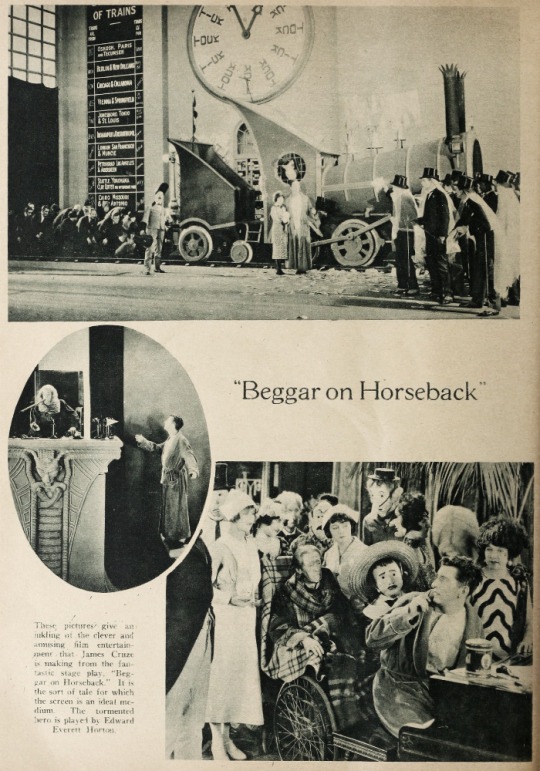
Stills from Beggar on Horseback from Picture-Play Magazine, August 1925
With all these complicating factors at play, how might have Salomé found its audience in 1922-3? Nazimova and Charles Bryant had innovative ideas for the film’s release that might have done the trick, if they had been able to act on them. Nazimova and Sam Zimbalist had finished cutting Salomé in late-spring 1922. Having spent practically all of her money to finish the film, and following A Doll’s House’s disappointing results, Nazimova was eager for Salomé to hit theatres. Though the film was in the can and private preview screenings had been held by Bryant by summer ‘22, Salomé wouldn’t be released until February of 1923. In studio filmmaking, holding a film in extended abeyance wasn’t ideal but it was not disastrous. Studios had significantly more resources and revenue streams than independent producers. If, for example, the release of Billions had been delayed for seven months, Nazimova still had two films on the Metro exchanges (and therefore in theatres) and Camille would have entered production in the meantime. But for Nazimova as an independent producer, this situation was wholly untenable. (In fact, Pickford, Fairbanks, and Griffith were in a similar untenable situation when they founded Allied.)
Initially, Bryant proposed roadshowing Salomé. Roadshowing is a release strategy for notable film productions where a film is toured around major cities, often with in-person engagements by stars, writers, and/or directors. Nazimova expanded the idea of touring with Salomé not simply as a roadshow, but paired with a short play in which she would star. Double the Alla, double the fun. As far as I can tell, there isn’t publicly available information about why Salomé wasn’t roadshowed. However, we do know that Griffith, as the only non-performer in UA, wanted to utilize different approaches for the release of his films—like roadshowing—and it became one of the major points of disagreement with his fellow UA decision makers. That could be taken as an indication that something similar might have occurred with Nazimova and Allied.
As time dragged on without a release date for Salomé and Nazimova returned to theatrical work—openly admitting to audiences that she was broke—Bryant took matters into his own hands. At the end of December 1922, Bryant negotiated with the owner of the Criterion Theatre in New York City for Salomé to run on New Year’s as a special presentation. In two days, Salomé grossed $2,630, setting records for the theatre. Adjusted for inflation, that’s $48,988.96. It was successful enough that the owner of the Criterion opted to hold the film over. This bold move must have lit a fire under Allied’s tuckuses, as Salomé finally had its first-run release a little over a month later.
In the 1920s, the first-run booking of a film was a crucial part of its further success. Concurrent nationwide release of films wasn’t the norm yet, and if a film was a big production, getting booked at high-capacity motion picture houses in major cities was a necessity. These big city releases would, in theory, generate interest in the film with exhibitors across the country and internationally. Basically, if you spent a lot on a movie but couldn’t land a first-run release, you weren’t likely to turn a profit or even break even. Salomé had a handful of first-run bookings and local reviewers from those cities believed the film would succeed. A reviewer from the Boston Transcript in February 1923 wrote:
“…this newest Salome is something far better than a photographed play. Considered both as picture acting, and as an interesting experiment in design, “Salome” is a notable production. It will have a far and wide reaching influence on future films in this country.”
But, as I mentioned, only a handful of first-run theatres played Salomé, and, taken collectively, the notices I analyzed from contemporary trades imply that it didn’t gain traction once it was made available beyond its initial run.

My cosplay of Nazimova as Salomé
During this regrettably short theatrical run, exhibitors and reviewers from trade publications advised that Salomé was a unique film that called for unique promotion. The overall assumption was that theatre owners knew their patrons and recognised whether out-of-the-ordinary movies were popular with them. Rather than purely judging a film’s quality, exhibitors and trade reviewers had concerns specific to exhibition when providing feedback. These concerns cannot be overlooked if you want to understand their assessments. For example, exhibitor feedback was very often informed by how high the rental fees were for a film, even if exhibitors don’t directly mention said fees. That is to say, a mediocre film might be rated highly if the rental fees were modest (and if block booking wasn’t an issue). Reviewers in the early 1920s, both for popular magazines and trade publications, were already accustomed to the formulaic nature of most studio output. Their reviews commonly expressed fatigue with studio films’ lack of originality. And, perhaps surprisingly, this sentiment was shared among theatre owners as well—particularly when a run-of-the-mill film was sold to them as anything other than a “programmer” (a precursor to B-movies).
What I have learned, not just by analyzing feedback for Salomé, but also for all of the films in my LBnF series, is that when a 1920s reviewer calls out bizarreness in a film, it’s not always a negative quality, even when the review isn’t positive. In the case of reviews written for exhibitors/theatre owners, focussing on what makes a movie different is purely pragmatic. It guides how exhibitors might market films to patrons and helps exhibitors judge if a film would be suitable for their audiences. And, from that same research, I’ve found significant indications there were numerous markets throughout the US that were hungry for novelty—contrary to what studio apparatchiks wanted to admit. So, pointing out Salomé’s bizarreness was a recommendation for those markets to consider renting it as much as it was a warning against renting for theatre owners who only had success with more conventional films.

Cover of the Campaign Book for Salomé reproduced in Exhibitors Herald, 9 February 1924
In the case of Salomé, reviews and feedback upon its release focused on two major points:
The film isn’t “adult” in nature. Well-known productions of Strauss’ opera and the 1918 Theda Bara film of the same name led to a presumption of salaciousness. (I talked a bit about that in Part One!)
The film deserves/requires a build up as an artistic event film.
Nazimova’s company helped exhibitors with the latter point in a few ways. The company provided Aubrey Beardsley inspired art posters conceived by Natacha Rambova and executed by Eugene Gise. They printed a book to guide promotion of an artistic spectacle. (So far, I haven’t been able to find a physical or digital copy, so I can’t assess how good the advice was!) Salomé was also distributed with an official musical score, apparently written for a full orchestra.
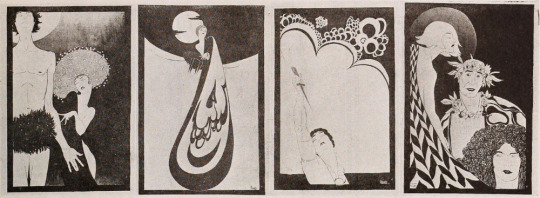
Art Posters designed by Rambova and painted by Gise as reproduced in Exhibitor’s Trade Review, 10 February 1923
The exhibitors who ran Salomé—and put at least some of this advice into practice—were satisfied with the business it did. By these accounts, the American moviegoing public was attracted by the novelty of Salomé, but what chance were they given to see it?
While this evidence of Allied’s poor distribution work may be circumstantial, it certainly complicates the narratives that Salomé was an unqualified flop or that average Americans weren’t (or aren’t) receptive to artistic experimentation. Given that Nazimova was not the only independent filmmaker who suffered from Allied’s inept distribution, it does seem like the underwhelming business Salomé did was due more to a poor choice of business partners than to any quality of the film or of American moviegoers. That said, with the increasing monopolization of the industry, Nazimova did not have a wealth of options.
Though Salomé was made and released at an tumultuous period for the US film industry, it did eventually find its audience through circulation in art cinemas. As the gap between experimental/avant-garde film widened in the US and the professional industry became less and less tolerant of departures from convention, Americans concerned with film as an art form rallied around amateur filmmaking clubs and art cinemas began popping up in cities by the middle of the decade. Salomé played in these theatres even after the advent of sound—occasionally even today. This is likely the key reason that Salomé survives and we’ve been able to continue to enjoy and reevaluate it one hundred years later.
Salomé is a significant film made at a significant moment in American film history. Nazimova took a major risk in going independent and personally funding two artistic projects. These films were founded on the beliefs that American moviegoers wanted art made by human beings with unique imaginations, feelings, sensibilities and that there was an audience for more than derivative, “machine-made” film. In my opinion, through close analysis of the circumstances of Salomé‘s release, we can see that Nazimova was likely correct, but didn’t get a genuine chance to prove it in her lifetime. Additionally, it’s important to note that Nazimova’s risks did not “ruin” her as is occasionally said. The state of her finances were more greatly affected in the 1920s by her fake husband’s habit of spending her money and by getting swindled by a pair of con artists over her estate, The Garden of Alla. Soldiering on, Nazimova continued to work in both theatre and film for the rest of her life and found more stability with the partner she would meet at the end of the 1920s, Glesca Marshall.
——— ——— ———
Once I finished this “Cosplay the Classics” entry, I realized that it would way too much for me to include a section on another relevant topic to Salomé: Orientalism in Hollywood. But, I feel that the topic is too important to just edit that writing out. Look out for a shorter “postscript” entry soon!
——— ——— ———
☕Appreciate my work? Buy me a coffee! ☕
——— ——— ———
Footnotes:
[1] Danse Macabre is also thought to be a major influence on Walt Disney animating to music, as seen in “Silly Symphonies” and later Fantasia (1940) and Disney’s other musical anthology features. It was also in this period that Disney fled from his debtors in the Midwest to California with his first “Alice” movie. However, the wide-ranging effects of Disney’s business practices were not felt until much later, so that’s another story for another time!
[2] Nazimova was one of a handful of women in Hollywood at the time who held significant creative power. June Mathis and Natacha Rambova, both of whom Nazimova regularly worked with, Mary Pickford and her regular tag-team partner Frances Marion are among some of the others.
[3] Chaplin wouldn’t produce a film for UA until 1923’s A Woman of Paris, as he was fulfilling a pre-existing contract with another studio.
[4] According to Gavin Lambert’s biography of Nazimova (which I discussed as a largely unreliable source in Part One), Robert Florey supposedly advised Nazimova against signing with them, citing Max Linder and Charles Ray as artists who had been “ruined” by their deals. However, the timeline does not quite match up. Though Florey did visit the set of Salomé, Nazimova had already signed the Allied deal by then and Ray had not finished The Courtship of Miles Standish (1923) when Salomé was in production. In fact, there was almost a year and a half between the completion of Salomé and the release of Standish. Whether this was a lapse of memory by Florey or misreporting by Lambert, I can’t be sure.
[5] Originally, I wanted to include Madonna of the Streets (1924) in my comparisons but, at the moment, Lantern has gaps in their Moving Picture World archive for 1924-5. I didn’t want to draw conclusions from incomplete data.
[6] Billions was also a Rambova-Nazimova collaboration. Rambova designed a fantasy sequence for the film.
[7] A mindset that’s still common among commercial media outlets today unfortunately. I could rant and rant about “content” and “content creation” all day but that’s another story for another time.
——— ——— ———
Bibliography/Further Reading
(This isn’t an exhaustive list, but covers what’s most relevant to the essay above!)
Lost, but Not Forgotten: A Doll’s House (1922)
“Nazimova in Repertoire” in Motion Picture News, 29 October 1921
“Alla Nazimova Plans for Her New Pictures” in Moving Picture World, 29 October 1921
“Nazimova Abandons Dual Program for Latest Film” in Exhibitors Herald, 24 December 1921
“Plays and Players”in Photoplay, February 1922
“PICTORIAL SECTION” in Exhibitors Herald, 4 February 1922
“New Nazimova Film May Be Roadshowed“ in Exhibitors Herald, 15 April 1922
“Newspaper Opinions” in The Film Daily, 3 January 1923
“Splendid Production Values But No Kick in Nazimova’s ‘Salome’” in The Film Daily, 7 January 1923
“Claims “Salome” Hit New Mark at N. Y. Criterion” in Exhibitors Herald, 27 January 1923
“Salome” in Exhibitors Trade Review, 20 January 1923
“Nazimova in SALOME” in Exhibitors Herald, 27 January 1923
“Nazimova Appeals To Exhibitors In Behalf of ‘Salome’” in Exhibitor’s Trade Review, 27 January 1923
“Novelty Features Paper and Ads for ‘Salome’” in Exhibitor’s Trade Review, 10 February 1923
“SALOME’ —Class AA” from Screen Opinions, 15 February 1923
Nazimova: A Biography by Gavin Lambert (Note: I do not recommend this without caveat even though it’s the only monograph biography of Nazimova. Lambert did a commendable amount of research but his presentation of that research is ruined by misrepresentations, factual errors, and a general tendency to make unfounded assumptions about Nazimova’s motivations and personal feelings.)
Lovers of Cinema: The First American Avant-Garde 1919-1945 ed. Jan-Christopher Horak (most notably, “The First American Avant-Garde 1919-1945” by Horak, “The Limits of Experimentation in Hollywood” by Kristin Thompson, and “Startling Angles: Amateur Film and the Early Avant-Garde” by Patricia R. Zimmermann)
United Artists: The Company Built by the Stars, Vol. 1 1919-1950 by Tino Balio
#1920s#1922#Salomé#salome#nazimova#alla nazimova#film history#cosplay#queer film#silent era#classic movies#film#avant garde#experimental film#cinema#queer film history#silent cinema#1923#classic cinema#american film#women filmmakers#women in film#silent film#classic film#silent movies#bisexual visibility#cosplayers#natacha rambova#united artists#Metro
20 notes
·
View notes
Note
Could I hear more of your thoughts on Doc Savage and the archetype he created? How does it relate to modern superheroes more specifically Reed Richards? (I know that you dislike Doc Savage, so sorry if this bothers you.)
Sorta like this, if we take a look at how Doc's archetype was formed and consolidated, and how that affected the Superheroes and Reed Richards specifically. (also please don't apologize, you all can ask me questions about whatever, seriously)

"Doc Savage" is recognizable in lots of other characters but there is a difference between specific pastiches or tributes or parodies of Doc (Doc Samson, Edison Rex, Jonas Venture), and characters who are evoking Doc Savage as his own archetype to draw initial inspiration from (Tom Strong, Bane, Clark Kent), and if we pull at Doc's roots we're gonna get to prior characters like Tarzan and Sherlock who were the ones to introduce or codify much of what are now commonplace superhero traits or the ones to introduce much of what Doc was originally pulling from.
I wanna draw some lines in the sand separating what is it that these characters brought to the table, in the road to get to Reed Richards and what exactly is it that Reed and Doc have in common vs things they have that are mainly taken from characters before them/grandfathered in their respective mediums. So let's go over the Archetypes here:
The Sci-Fi Superman: Coined by Peter Coogan. Through some strange birth or scientific intervention, these characters have superhuman powers and abilities that set them irrevocably apart from humanity, nearly forcing them to usually fall into the roles of saviors, rulers, destroyers, or ostracized/self-imposed hermits. Unless they find a purpose requiring said abilites, they cannot be permitted to exist and usually meet a tragic demise or is stripped of said power. Formative example is The Creature from Frankenstein (Mary Shelley), and others include Hugo Danner from Gladiator (Phillip Wylie) and Bill Dunn from The Reign of The Superman (Jerry Siegel). Coogan considers John Carter the first wholly positive and heroic SF superman, which is disputable, but more on Carter later.
Pulp Ubermensch: The Great Man turned do-gooding adventurer with a prosocial agenda. A human who is physically, mentally, and/or morally superior to those around him as a result of training/upbringing, skilled at everything the story requires him to, who applies his talents and abilities near-exclusively to fight evil. Formative example is Nick Carter (created by John R. Coryell and penned by Frederick Van Rensselaer Dey), who established much of what would eventually become pulp hero and superhero convention consequently.
The Great Adventurer: I'm naming these as a counterpoint to The Great Detective, the fantastical globetrotting adventurer/explorer hero who can go anywhere and do anything, who takes to the world as the detective takes to the city. The idea of a wealthy, offbeat, yet good-natured pulp hero who goes around righting wrongs with like-minded assistants. Formative example here is Rocambole (Ponson du Terrail), in most ways a definitive early Pulp Ubermensch, and arguably the first proto-superhero to assemble a gang of odd companions with a variety of talents and backgrounds to aid him, which is what both the Fabulous Five and the Fantastic Four can trace roots back to.
Pulp Supermen: Offshoots of the Sci-Fi Superman as adventure protagonists in serialized stories, where their superhuman natures and status are alleviated and redirected by the need of their capabilities somewhere or in service of something, and thus they get around the ruler/savior/destroyer fate by being heroes with a social calling akin to the Pulp Ubermensch, dedicated to use their powers near-exclusively to fight injustice without rocking the boat of society by their presence (or if necessary, assert dominion ONLY in a setting outside of human society, such as the jungle or Martian civilization). Distinguished from the Pulp Ubermensch by their greater larger-than-life explicitly superhuman abilities, that they don't need to be morally/mentally superior to the extent of a Pulp Ubermensch, and by the fantastical settings and tone of their adventures. Formative examples are John Carter of Mars and Tarzan of the Apes (both created by Edgar Rice Burroughs), with Tarzan quoted by Lester Dent as a specific influence on Doc (there are others but we're skipping most of those not relevant here)
The Science Adventurer: A frequently-used name to describe Doc Savage and Doc Savage-alikes. Doc Savage can be described, in archetype word salad terms, as a Pulp Superman who calls upon the Pulp Ubermensch's great man-ness and urban social calling, and who combines a Sci-Fi Superman origin and physical traits with The Great Adventurer's explorer disposition, righteousness and band of companions. The main thing that sets him apart from the characters listed prior is his focus on scientific prowess, technology, reasoning and polymathic skills, the importance of the "Doc" part of his name as it where.
The Superhero: you already know what these are and how they relate to the above. I've written a couple of things about the differences between pulp heroes and superheroes and it's a subject I'm of constantly mixed opinions on even regarding stuff I wrote, so I'm linking these two written a year apart if you want an idea of where those differences are.
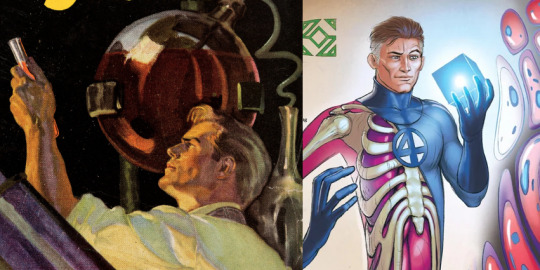
And so we get to Reed, who I'm naming a Science-Adventurer Superhero as a merger of the last two. Both Stan Lee and Jack Kirby mentioned several times that they read Doc Savage aplenty during the Depression and it shows in elements such as the Baxter Building (an expansion of Doc's headquarters in the Empire State Building - instead of just the 86th floor, The Four get the entire skyscraper), the specialized aircraft and vehicles, the fights and antagonism between the cantankerous and anti-social Ben Grimm and the smart-mouthed Johnny Storm mirroring the bickering spats between the bestial Monk and the silver-tongued Ham, and of course Beast from X-Men being more closeled modeled on Monk's ape-ish traits and scientific expertise (there's a fairly large argument to be made, that I think accounts for some of why Beast is, like that, in recent comics, that Ben Grimm and Hank McCoy both divided Monk Mayfair's every trait between themselves and ultimately flipped the script in the long run before taking it to the farthest extremes possible as polarized opposites of each other, with Ben initially getting most of the bad parts and making them the best ones, and Hank initially getting all the good ones and making them into the worst ones)
As far as I know, Reed Richards was not consciously modeled after Doc Savage (although Jack Kirby and Joe Simon's Private Strong used the origin story of a professor raising his son in a lab to be perfect in total isolation of other humans, which Lester likely may have pulled from Phillip Wylie's The Savage Gentleman to begin with), although it's commonly said that the direct precursors of the Four, the Challengers of the Unknown, were modeled after Doc Savage and the Fabulous Five's make-up. The members of the Fantastic Four are all based on 50s sci-fi archetypes, with Reed as the quintessential scientist, the grey-templed pipe-smoking patriarch frontman of the expeditions, and some creators over the years seem to have drawn upon Doc Savage as a model Reed. I'm thinking specifically of Mark Waid here, who openly named Doc Savage in his pitch bible:
The eternal problem with Scientifically Inclined Genius Adventures, the reason they don't ring true, is because in real life scientists spend all their damn time in the lab. Not Reed.
F'r pete's sake, we know he undertook all sorts of Indiana Jones missions as a younger man, we've seen that he actively enlisted in a war, and oh yeah, he stole a rocketship and tried to take it to the moon."
Tommy B put his finger on it when he suggested I stop thinking of Reed as the Professor from Gilligan's Island and instead think of him more like Doc Savage. When Reed encounters mental or logistic obstacles in his quest for knowledge, he thinks through them.
Doc Savage, of course, isn't the perfect model - he's a little more blood-and-gristle than Reed, more invested in the search for justice than for knowledge, and a little more "in the moment" as a general rule. Reed's more like Peter Weller as Buckaroo Banzai, they have the same aloof, detached nature. Unless active danger is staring him right in the face, Reed often seems a bit distant and not completely here because his mind is ten minutes in the future.
That addresses the Science-Adventurer aspect, which leaves us with the Superhero side of the equation.

With Doc Savage you of course have one of the, if not the, main archetypal pulp heroes, a character that both Superman and Batman would take a great deal from, and "pulp hero" in itself is a term that exists to define these characters more so in relation to superheroes than what they were actually like in their own stories, time periods and mediums. The superhero as a concept is founded on Superman and Batman and their dychotomy. Costumed Avenger vs Ubermensch, mortal and immortal, light and dark, Dayman and Nightman (AHH-ahhh-AAHHHHH!), and that dynamic is specifically a result of Superman and Batman being direct descendants from Doc Savage and The Shadow respectively, who were Street & Smith's (and by extension the American pulps) Big Two, the top dogs of 1930s hero pulps, and direct opposites to each other.
Doc Savage was created in response to The Phantom Detective (who was the first successful Shadow imitator and thus defined it as the thing everyone was gonna have to do or respond to) and was in many ways a modernized revamp-almost-copy of Street & Smith's Nick Carter during his heyday, in origin and first case and super strength and omnicapable skills and general Great Man-ness and gadgetry and mission statement and so on. Doc was co-created by the editor of Nick Carter Magazine, John Nanovic, and the first response to the Phantom Detective that S&S planned was a reboot of Nick Carter as a generic hardboiled detective, published on March 1933, the same month as Doc's debut, and obviously Doc would go on to achieve much greater success and thus would popularize those traits again with himself as the figurehead archetype of them (not unlike what Superman and Batman would later do).
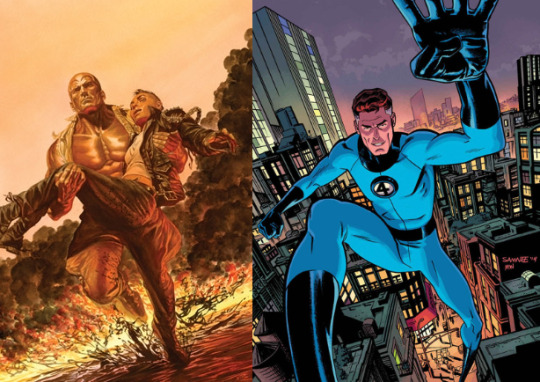
Unlike The Shadow, Doc Savage does not operate under a secret identity or mask. He is not the hidden master of the city and has no division between his alter egos, and because he performs in broad daylight as a celebrity, is theorically held to social scrutiny, and is fully sanctioned and approved by law enforcement and works with the authorities with public transparency (minus the crime college but let's just, not, for now), it greatly upends and affects the approach he takes to fighting crime. He only has one identity, the greatest man of all time as the stories will remind you at every turn, by his author's own words he "manifests Christliness", and while not much separates Doc Savage's skills from Nick Carter's, he is explicitly and textually framed as superhuman (even a "superman", that term was deployed a few times), and he operates in a contemporary, urban setting that most Pulp Supermen cannot touch without veering into Sci-Fi Superman territory.
Within the hero pulp format that S&S started with Nick Carter and renewed with The Shadow, with the scientific explorer angle, you could argue Doc Savage, in almost exactly the same way as he does in his stories, worked out the solution to an unfixable problem: Turns out you can be as over-the-top super as you want, so long as you have a procession of equivalent super menaces to fight, don't upset society (and if you do it, not where the public where can see, keep it a secret that you can be blackmailed over by crooks you will inevitably silence okay look I'll stop now), have whatever incredible miracle cures and achievements and charity you do work on take place off screen where you never have to deal with them too seriously, and know how to pick your fights.
His service to others resolves the ruler/savior/destroyer conundrum. Savage aids individuals who face problems beyond their control, does great work in advancing medicine and science, and alleviates suffering through charity work, but he leaves the institutions of society in place.
He faces a never-ending succession of villains threatening society, an eternal frontier of gangsters and super-scientific menaces who play the role that Indians take in frontier narratives. The unresolvable nature of crime makes this frontier eternal, so Savage can place his superiority in service to the community and never risk turning into a ruler, savior, or destroyer because he can find challenges sufficient to absorb his energies.
The Savage solution—the hero position would be adopted by the creators of other prosocial supermen to come, including Superman, although only the adventures of Superman would be set in contemporary America.
Thus instead of marking an end to the bourgeois domination of society, as Nietzsche foresaw, the superman serves to protect that domination through myth-narratives. - Superhero: The Secret Origin of a Genre, by Peter Coogan

Reed Richards, in turn, is defined (INCORRECTLY, I say, feeling a plasma crackle barely miss my skull) as the smartest man on the planet, a mental superhuman who operates on a level above and beyond that of everyone around him, and a freak accident during a space travel grants him physical superhumanity to match, with his body able to morph and bend under his will. He alleviates the ruler/savior/destroyer conundrum Coogan described in much of the exact same way described above, kept busy with an endless procession of strange dimensions and aliens and supervillain challenges, and Mark Waid's famous confession scene in Fantastic Four #489 addresses the fate that looms over the Sci-Fi Superman directly, with the "very arrogant man who did something very stupid" pointificating to his toddler child just how necessary it was to ensure that the world would not fear and destroy the people he'd irreversibly mutated as a result of hubris, what is even the point of his grandstanding title and colorful outfit and public adventures and all that.

The life of superpowered adventurer celebrities was a necessity, and his superhero persona, Mr Fantastic, is a tabloid-catching act of penitence to mask his ultimate shame and to compensate the people he loves most. He lives for science, he craves discovery above all, but as far back as the Lee/Kirby stories, he still drags the team into awful intrusive press conferences none of them want to go but must, he sits through meetings with hardass generals to buy his team more leeway and trust, he takes the time to stretch across the city to visit sick children in hospitals and say hello to passing helicopters, he has to be the stick-in-the-mud dad who stretches himself thin to keep Johnny and Ben from ditching the team or seriously hurting each other (those first Johnny and Ben spats get way more violent than you'd expect), and he has to make difficult and even manipulative and harsh decisions even then to save the most lives he can. He carries a responsability to his family and loved ones first and foremost, and fashioning himself and them into superheroes is how he lives up to that responsability. It's what allows them to exist and thrive in-universe as much as out of it.
(We're not gonna play catch-up to the "why doesn't Reed Richards cure cancer" conversation but even that, in itself, is an extension of a thread that we can trace back to Doc and the Sci-Fi Supermen before him, when seams in the fantasy start showing with the introduction of consequence, a trend that particularly catches up to these scientist superhero characters who followed in Doc Savage's wake, and obviously caught up to Doc himself several times by now, for reasons @artbyblastweave describes as "a consequence of contemporary writers being Allowed To Notice And Unpack Things" and elaborates on very neatly here)
As a superhero, Reed Richards exists in conversation with Superman and Batman, same as every other character within the superhero "genre", which means he also exists in conversation with those traits borrowed from Doc Savage, and The Shadow, and all these other guys listed who were crucial in their development and a lot of others I'm leaving out of the conversation for now. A crucial part of that conversation and where the Fantastic Four figure into it is the fact that they were designed to not be traditional superheroes but to flip most if not all the conventions established on it's head, a part of that being their initial lack of uniforms (and when they did get uniforms they were just that, uniforms, rather than costumes), the lack of a secret identity, and the fact that the Four are scientists and explorers first, and crimefighting superheroes a distant second they're forced to frequently make a close second or first priority. Marvel made it's big defining pop culture splash with the Fantastic Four by turning superhero convention on it's head and doing as much as they could to do the opposite of what Brand Echh was doing.
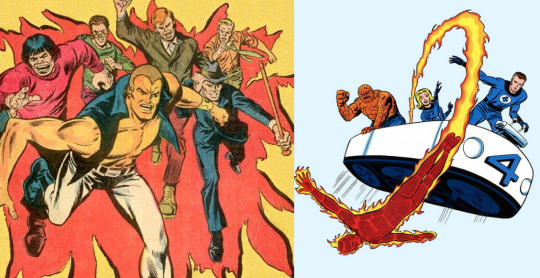
And that's kinda the main reason they end up inviting similarities with Doc Savage and other pulp heroes, because they're going out of their way to imitate and subvert traits and tropes that Superman and Batman were already imitating and subverting from those guys in the first place, that they in turn were imitating and subverting from guys that came before them, and etc.
Archetypes are breakthroughs, and no breakthrough happens in a vacuum. In the end, a lot of these strands and connections between these characters are less specifically the result of writers consciously following in the footsteps of Doc Savage and those that came before or alongside him, and more so with the fact that there's only so many left turns you can take before you just end up in a circle, or reinventing the wheel as it were.

#replies tag#pulp heroes#pulp fiction#superheroes#marvel#marvel comics#doc savage#lester dent#reed richards#fantastic four#stan lee#jack kirby#mark waid#comics
73 notes
·
View notes
Text

BERENICE ABBOTT, CONSOLIDATED EDISON POWER HOUSE, FIRST AVENUE BETWEEN EAST 38TH AND 39TH STREETS, 1930S
93 notes
·
View notes
Text
A list of things I want or need to do.....
Schedule driving lessons
Work on unicorn painting
Work on illustrations for steph book
Work on 'cinderell' comic rewrite/update
Laundry today
Dishes+ run dishwasher today
Schedule dentist appt
Schedule vet visit for Edison- he has a cold or allergies or something, also a growth on one of his toes??, and I want to really in-depth discuss a plan for his weight bc ive had no success. Also he's due for annual vaccinations presumably, so. (Wish blue pearl was not so expensive bc they now have Fear Free vet visits and the difference in his behavior when we went there last time compared to other vets weve gone to was just amazing. He was able to wander around the room and it didn't feel like a typical exam room for pets so he wasn't scared and hiding, he allowed the vet and assistant to poke and prod him and manhandled him even if he wasn't thrilled, he didn't cry or hiss or scratch anyone! But for regular vet visits they're really pricey :/)
Work on Eitan and Zahav story/comic
Work on iron man/dragonriders of pern au story
Buy parts for pvc watering system for garden (need to go with dad) and set up
Work on bookcase (with dad)
Window-shop/buy stuff for steph bridal shower (with ma or on my own, but the best store to go to is far enough I'd rather go by car, and it's more fun to go with someone else and discuss ideas and also less likely to impulse buy everything?)
Go to DSW to get new sneakers (with ma, access by car travel only and easier to have a second opinion on shoes. My current pair I have a hole in the top by my big toe...oops)
Work on website: photograph artwork professionally, edit photos, design website layout and complete that. Add artwork to portfolio gallery on the site, add my photo and about me info. Request refund for the dumb add-on I didn't realize was useless. Make the website what I want it to be. May need to learn coding. Need to slim down choices for artwork to include to only the best stuff it makes sense to include, not just things I like.
Design pride plants stickers/pins
Plan for rainbow enamel or just hard enamel autisticat pins. Also, keychains?
Rework/update etsy listings/items available...
Come up with additional ideas for products. Stickers/prints/pins...keychains?
Fulfil current etsy order - soon
Organize my room - try on clothing, go thru piles of stuff, figure out what to do with certain things and if the new bin will help what to put in it, decide what to put back into drawers and which ones for what items, go thru some other stuff like bank statements, organize receipts, etc
Put shelf above window above curtain rod for displaying some stuffed toys (need dad's help)
Hang up new Queer pride flag (need help, also it's way bigger than I expected so may need to fold some of it behind and stitch it to itself to fit on the wall, need help to pin it up on the wall and probably a second step stool at least)
Look for vases for bridal shower for flowers (with ma or solo)
Go thru and organize stuff on breakfast bar
Plan out a budget - figure out how much I tend to spend on different categories of stuff per week or every 2 weeks or monthly, figure out how much I earn in that time period (if it's weekly it's half of my pay bc I'm paid every other, if it's monthly gotta double that amt, also gotta average it out/pick a general usual amount since depending on how much OT I do my pay is more or less lol). Consolidate that info together to decide on a basic budget for each category/ overall spending for the time period.
make list of things I need/want to buy or tend to buy, marked with priority or how often for repeat purchases, compare with budget for what impulse items/wants I can acquire in a given time frame and which to save for the next etc
Get a new bike or get mine fixed...
Spend time outside/go on walk
Water plants
Draw for fun. Draw tony or stevetony or dragons or cats
Read...
Get ice cream at some pt like tomorrow night if I'm off Thursday or on Thursday if I'm off Friday 🥺🥺🥺
Plan days to do activities! Kayaking/beach/farmers market/street fair/museum. With steph?
Plan to do something fun w work friends outside of work
Pride fest: who is going with me?
Renfair when it's time???
Pay for tallis!!! Today preferably! Write check and take it over to shul?? (Or give to ma to take to services this evening or go with her?)
1 note
·
View note
Text
More than four million customers of New York City’s largest utility company, Consolidated Edison, were asked on Saturday to conserve energy “until further notice” because of the frigid weather, which has prompted increased demand on gas pipelines.
Con Edison said in a news release that its call for conservation would affect 1.1 million natural gas customers and 3.5 million electric customers.
“Conserving energy as much as possible now will help ensure adequate natural gas supplies for the rest of the weekend,” the company said in a statement.
In addition to asking customers to conserve, Con Ed said that it had also been using liquefied natural gas and compressed natural gas as additional supply sources.
The company recommended that customers set thermostats at the “lowest comfortable temperature,” use appliances only as needed and hold off on using dishwashers, washing machines and dryers.
Con Edison asks New York City customers to conserve energy.
putyin terve!
6 notes
·
View notes
Text

Union Iron Works of Los Angeles (Photo taken by me on July 27, 2024).
Another not sidewalk. Sorry! But this is an interesting placement, isn't it?
Union Iron works of Los Angeles, Inc. was founded in 1884 according to Victor C. Darnell's Directory of American Bridge-Building Companies 1840-1900 (Society for Industrial Archeology, 1984). To be included in this directory, the company had to build bridges or advertise that they built bridges, even if it was only once and "not their usual activity." However, according to the finding aid for LA County Incorporation Records collection of the Seaver Center for Western History Research, the articles of incorporation were filed in 1899, with principles D. P. N. Little and Horace G. Miller.
It's president in 1907 was Little, per this personal update:

(San Pedro Daily News, Volume 5, Number 249, July 3 1907, accessed via UCR Center for Bibliographical Studies and Research California Digital Newspaper Collection). Interestingly, Little and Union Iron Works are listed separately in the aforementioned Directory of American Bridge-Building Companies, but with overlapping time periods. It's possible that Little was included as an engineer "who advertised as bridge builders, signing contracts for complete projects, making the designs, and subcontracting the actual construction."

Los Angeles Herald, Volume 35, Number 184, April 3 1908, accessed via UCR Center for Bibliographical Studies and Research California Digital Newspaper Collection.

Little was vice president of the Founders' and Employers' Association and Manufacturers' Association of Los Angeles, which this labor paper wasn't so happy about (Industrial Worker, Spokane, WA, June 22 1911). I'm just going to include some snippets:


They owned this tract, according to LA County Public Works land records recorded July 10, 1914.

The National Park Service National Register of Historic Places Inventory--Nomination Form for the Chapman Building (1922-23) in Fullerton, CA includes a listing of local companies involved in the construction. Union Iron Works of Los Angeles, for steel work, are the first in the list!
In 1924, they won the bid to erect eight steel factory buildings for Western Glass company in Fullerton, CA ("Give Contract for Factory Buildings," The Register, Santa Ana, CA, Monday, February 4, 1924, page 14, accessed via Newspapers.com).
In the same year, they were listed in the Directory of California Manufacturers for 'structural iron, iron work' at 5125 Santa Fe Av, Los Angeles (California Development Association, 1924, via archive.org). This address seems to no longer exist.

They built a plant northeast of "the latest subdivision" in 1927, near plants for Truscon Steel company and Goodrich Tire & Rubber and a Southern California Edison company sub-station ("Laguna-Bell and Maywood Gardens Put on Market," Daily News, Los Angeles, CA, Thursday, June 23, 1927, page 10, accessed via Newspapers.com).
In 1928, Union Iron Works merged with Llewellyn Iron Works and Baker Iron Works to become Consolidated Steel Corporation, which is now part of U.S. Steel.
In a 1954 publication by Cal Tech, we learn that Alden G. Roach, at the time president of the Columbia-Geneva Steel and Consolidated Western Steel Divisions of the United States Steel Corporation, was newly elected to the Institute Board of Trustees ("The Summer," October, 1954). He had been at the company since it had been Union Iron Works of Los Angeles (and was that endeavor's president in 1941).
See below for an update from 1955 from the earlier discussed Directory of American Bridge-Building Companies:

0 notes
Text
About Us
Bio-One of NYNJ is a leader in crime scene cleanup and biohazard decontamination services in New York and New Jersey for a reason. The scenes we remediate can be overwhelming and dangerous. We are trained, experienced, and here for you. Contact us anytime, day or night. We answer the call 24/7.
Contact Us
WHO WE ARE
The right people,
here for you
At Bio-One of NYNJ, we are a close-knit team devoted to helping our community.
Our mission is simple: help first, business second.
We value: professionalism, discretion, expertise, and care and compassion for everyone involved.
View Services

Compassion & Understanding
Our priority is you. Bio-One of NYNJ, to this day, continues to be the most passionate and caring crime scene cleanup and biohazard decontamination company in the cleaning services industry. We have built our company on the foundation of discretion and confidentiality. We treat each situation with care and compassion, and take time to learn your individual needs and goals. We can open your insurance claim and work with adjusters so you can focus on other urgent matters. We strive to make a difference in our community and thrive by going above and beyond for our clients at Bio-One of NYNJ.
About Your Local Owner
We are a help first business, and we do it because we care.

James Wurts
Owner
James Wurts is the owner of Bio-One of NYNJ. James grew up in New York City (Staten Island) and worked for 14 years on Wall Street, then went on to work for 8 years for Consolidated Edison of New York. James received his Master's Degree in Occupational Health and Safety from Columbia University. James' years working safety for the utility company has allowed him to bring a degree of expertise to bio-hazard incidents, along with understanding that the customer always comes first. James is an active member in his church that allows him to volunteer to help the less fortunate in his community. James and his wife Cristy have 3 children.
#Biohazard Cleaning Services#Commercial cleaning service#infectious disease cleanup#24/7 Service#Specialists in Disinfection#Sanitation and Decontamination#Cleaning & Sanitation#Cleaning Services#House Cleaning and Mold Remediation
0 notes
Link
Check out this listing I just added to my Poshmark closet: 🎁 Red Lantern Electric Vintage Metal Handlan St Louis USA Glass Globe Railroad
0 notes
Text
Death Care Merchandise Services Market Outlook: World Approaching Demand & Growth Prospect 2024-2030
Death care is the planning, delivery, and enhancement of post-death services, products, policies, and governance. Companies and organisations that provide death-related services such as funerals, cremation or burial, and memorials are included in the death care merchandise services. This includes, for example, funeral homes, coffins, crematoria, cemeteries, and headstones. The death care industry is primarily made up of small businesses, though there has been significant consolidation over time. The death care services are contentious due to the exorbitant costs of services, as well as the negative impact of traditional funeral practises. Death care companies' practises are frequently backed up by onerous state regulations that raise prices and worsen environmental effects.
Free Sample Report + All Related Graphs & Charts @: https://www.advancemarketanalytics.com/sample-report/184533-global-death-care-merchandise-services-market?utm_source=Organic&utm_medium=Vinay
Latest released the research study on Global Death Care Merchandise Services Market, offers a detailed overview of the factors influencing the global business scope. Death Care Merchandise Services Market research report shows the latest market insights, current situation analysis with upcoming trends and breakdown of the products and services. The report provides key statistics on the market status, size, share, growth factors of the Death Care Merchandise Services The study covers emerging player’s data, including: competitive landscape, sales, revenue and global market share of top manufacturers are Service Corporation International (United States), Carriage Services, Inc. (United States), Hillenbrand, Inc. (United States), Alderwoods Group (United States), Matthews International Corporation, InvoCare (Australia), The Co-operative Group (United Kingdom), Dignity plc (United Kingdom), StoneMor Partners L.P. (United States), Propel Funeral Partners (Australia),
Thanks for reading this article; you can also get individual chapter wise section or region wise report version like North America, Europe or Southeast Asia.
Contact Us:
Craig Francis (PR & Marketing Manager)
AMA Research & Media LLP
Unit No. 429, Parsonage Road Edison, NJ
New Jersey USA – 08837
0 notes
Text
youtube
According to a new report by Bankrate.com, the hidden costs of homeownership add up to an average of $18,118 annually, or $1,510 per month.
Today's Stocks & Topics: VIX - CBOE Volatility Index, Market Wrap, Investment Criteria, Ordinary vs. Qualified Dividends, Be Prepared for the Hidden Costs of Homebuying, BIG - Big Lots Inc., The International Energy Agency (IEA) Report, URA - Global X Uranium ETF, ED - Consolidated Edison Inc., META - Meta Platforms Inc., Whole Foods & Trader Joe’s.
Video Content Details
00:00 Introduction
02:11 VIX - CBOE Volatility Index
07:15 Market Wrap
10:43 Investment Criteria
12:54 Ordinary vs. Qualified Dividends
15:37 Be Prepared for the Hidden Costs of Homebuying
22:49 BIG - Big Lots Inc.
24:59 (IEA) Report
30:28 URA - Global X Uranium ETF
34:49 ED - Consolidated Edison Inc.
39:25 META - Meta Platforms Inc.
43:21 Whole Foods & Trader Joe’s
Call 888-99-CHART to hear your questions answered live.
0 notes
Text

Which Dividend King stock offers the highest yield?
Dividend Kings are companies that have consistently increased their dividends for at least 50 consecutive years. While they offer reliability and stability in dividend payouts, their dividend yields may not always be the highest among all dividend-paying stocks. The yield can vary based on factors such as the company's stock price and dividend payout ratio.
As of my last update in January 2022, it's essential to check the most recent data since stock prices and dividend yields can change over time. However, historically, some Dividend Kings with relatively high yields have included companies like AT&T (T), Consolidated Edison (ED), and ExxonMobil (XOM). Keep in mind that a high dividend yield doesn't always mean it's the best investment, as it could also indicate a struggling stock price or unsustainable dividend payout ratio. Always do thorough research before investing in any stock.
LTP Calculator Overview
LTP Calculator is a comprehensive stock market trading tool that focuses on providing real-time data, particularly the last traded price of various stocks. Its functionality extends beyond a conventional calculator, offering insights and analytics crucial for traders navigating the complexities of the stock market.
Also Available on Play store - Get the App
Key Features:
Real-time Last Traded Price:
The core feature of LTP Calculator is its ability to provide users with the latest information on stock prices. This real-time data empowers traders to make timely decisions based on the most recent market movements.
User-Friendly Interface:
Designed with traders in mind, LTP Calculator boasts a user-friendly interface that simplifies complex market data. This accessibility ensures that both novice and experienced traders can leverage the tool effectively.
Analytical Tools:
Beyond basic price information, LTP Calculator incorporates analytical tools that help users assess market trends, volatility, and potential risks. This multifaceted approach enables traders to develop a comprehensive understanding of the stocks they are dealing with.
Customizable Alerts:
Recognizing the importance of staying informed, LTP Calculator allows users to set customizable alerts for specific stocks. This feature ensures that traders receive timely notifications about significant market movements affecting their portfolio.
Vinay Prakash Tiwari - The Visionary Founder:
At the helm of LTP Calculator is Vinay Prakash Tiwari, a renowned figure in the stock market training arena. With a moniker like "Investment Daddy," Tiwari has earned respect for his expertise and commitment to empowering individuals in the financial domain.
Professional Background:
Vinay Prakash Tiwari brings a wealth of experience to the table, having traversed the intricacies of the stock market for several decades. His journey as a stock market trainer has equipped him with insights into the challenges faced by traders, inspiring him to develop tools like LTP Calculator.
Philosophy and Approach:
Tiwari's approach to stock market training revolves around education, empowerment, and simplifying complexities. LTP Calculator reflects this philosophy, offering a tool that aligns with his vision of making stock market information accessible and understandable for all.
Educational Initiatives:
Apart from his contributions as a tool developer, Vinay Prakash Tiwari has actively engaged in educational initiatives. Through online courses, webinars, and seminars, he has shared his knowledge with aspiring traders, reinforcing his commitment to fostering financial literacy.
In conclusion, LTP Calculator stands as a testament to Vinay Prakash Tiwari's dedication to enhancing the trading experience. As the financial landscape continues to evolve, tools like LTP Calculator and visionaries like Tiwari sir play a pivotal role in shaping a more informed and empowered community of traders.
0 notes
Text
2. Con Edison Faces Declining Earnings and Revenue in Fiscal First Quarter of 2024 $ED #NYSE
Consolidated Edison Inc.'s Financial Results Reflect Challenges, but Company Remains Resilient Consolidated Edison Inc. (Con Edison) recently released its financial results for the fiscal first quarter of 2024, which saw a deterioration in earnings per share and revenue year-on-year. Despite these challenges, Con Edison remains committed to enhancing shareholder value and maintaining stability in the industry. This article will analyze the key financial figures, interpret their implications, and outline how they might impact the company going fo
0 notes
Text
Achieving Financial Stability with a Bankable Loan in Edison, NJ, and Woodbridge

Starting a business is no mean feat. It takes an enormous amount of courage, dedication, and resources to turn your dreams into reality. But the journey doesn't end there; in fact, it's just the beginning. One of the biggest challenges entrepreneurs face is achieving financial stability for their business. This can only be done by having enough capital to invest in operations, marketing, and growth. That's where bankable loans come in. In this blog post, we'll explore how getting a bankable loan Edison, bankable loan NJ, and bankable loan Woodbridge can help you achieve financial stability for your business.
A bankable loan will help you meet your business needs.
No matter what stage your business is at – whether you're starting up or looking to expand – you need money to fund your operations. A bankable loan can provide you with the capital you need to purchase equipment, inventory or hire employees – all necessary steps to take your business to the next level.
Getting a bankable loan will improve your credit score
Taking out a bankable loan is a great way to establish credit for your business. As long as you make timely payments on your loan and keep your debt-to-income ratio low, having this type of debt can actually boost your credit score.
Bankable loans typically have lower interest rates
Compared to other forms of borrowing such as personal loans or credit cards, bankable loans usually have lower interest rates. This means that over time you'll pay less money back than if you had borrowed from another source.
Bankable loans are flexible
Bankable loans come in all shapes and sizes – short-term or long-term; secured or unsecured; fixed or variable interest rates – so you can find one that suits your specific needs and circumstances.
You can use a bankable loan to consolidate debt
If you have multiple high-interest debts or credit cards, you can use a bankable loan to consolidate them into one manageable monthly payment. This will simplify your financial situation and potentially save you money on interest charges.
Achieving financial stability is crucial for the success of your business. A bankable loan can provide you with the necessary capital to invest in your operations and grow your business. Additionally, taking out a bankable loan can help establish credit for your business, improve your credit score, offer lower interest rates, and increased flexibility for repayment terms. If you're looking to achieve financial stability for your business in Edison, NJ, or Woodbridge, consider getting a bankable loan today.
0 notes